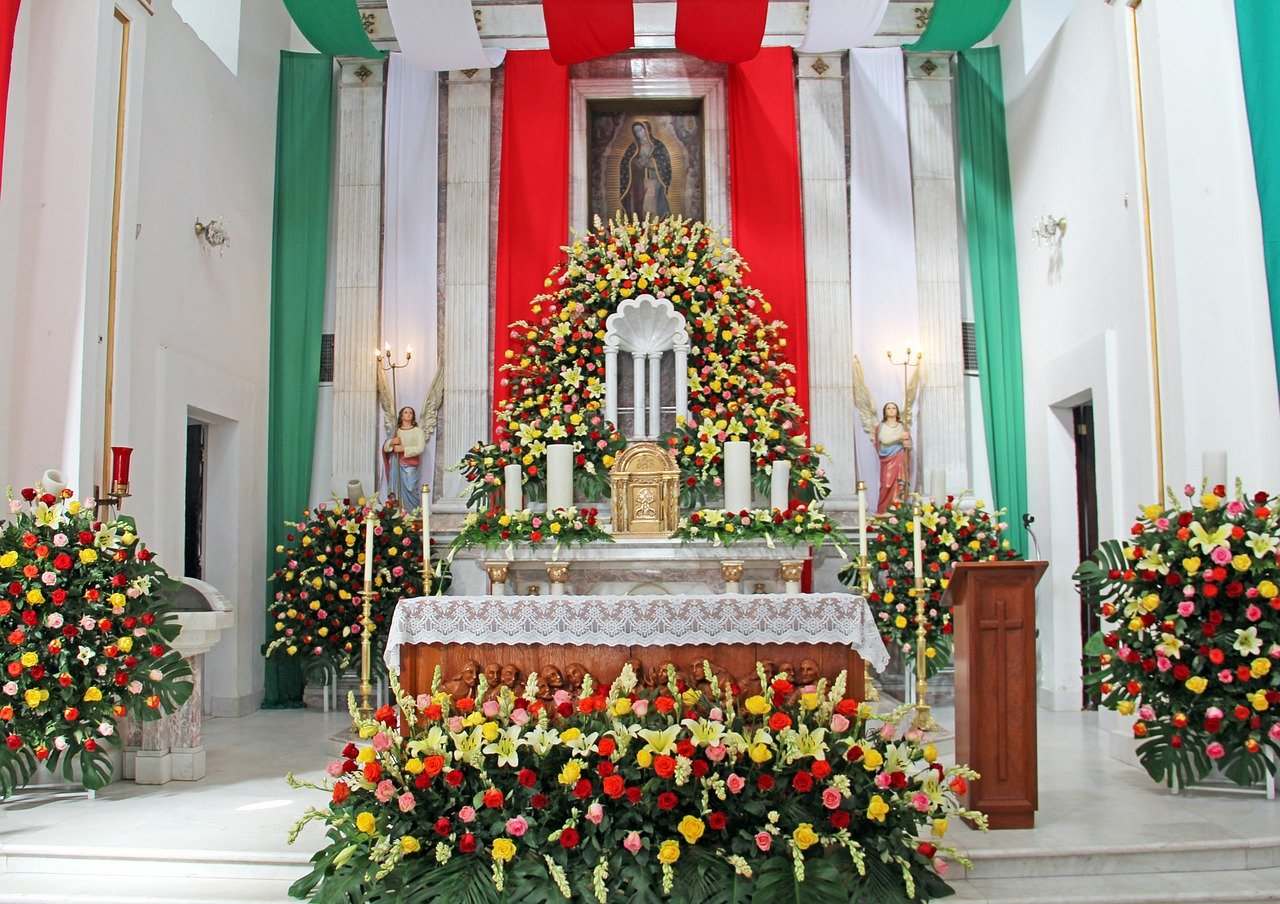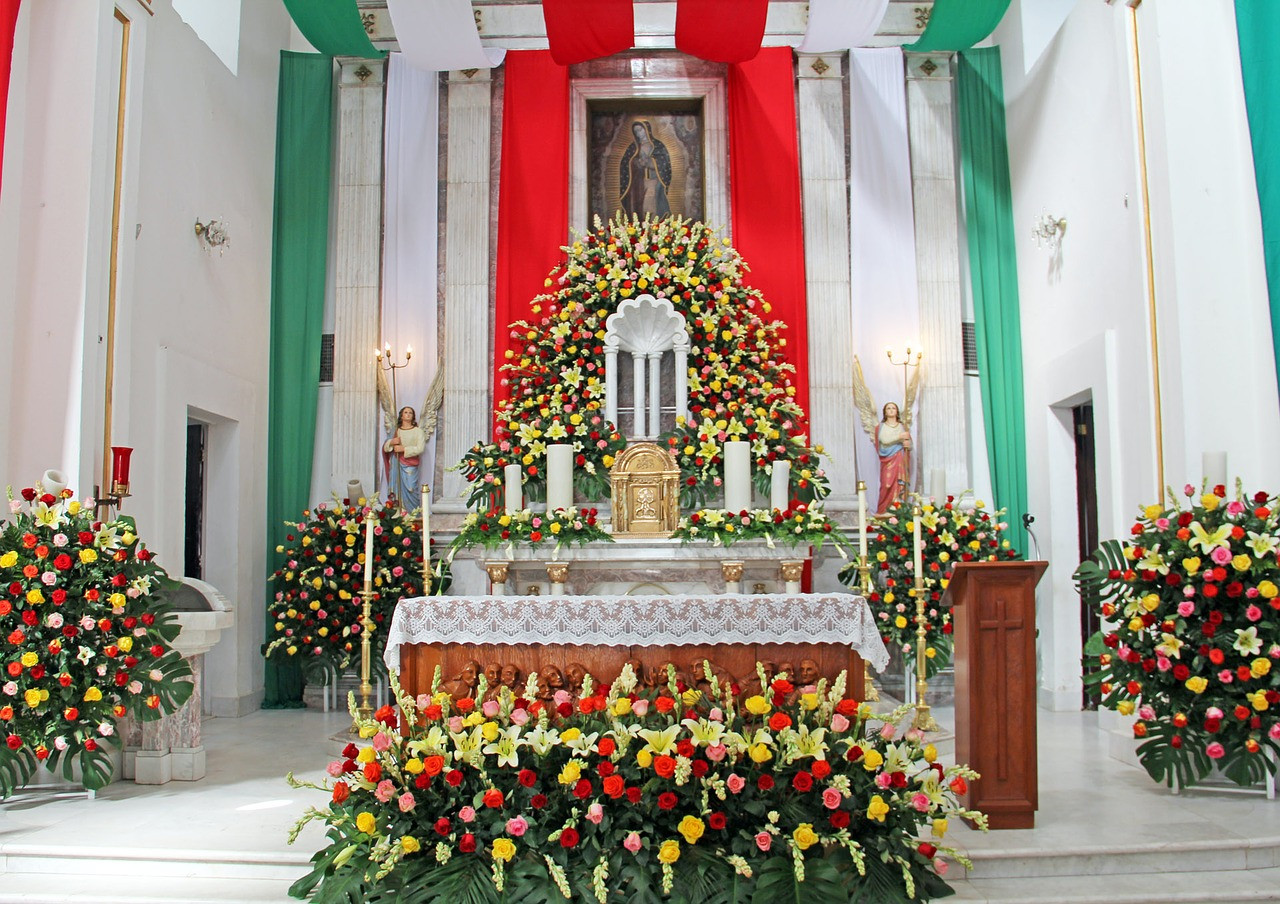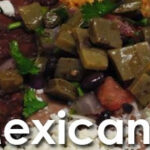Easter in Mexico, or Semana Santa, is more than just a religious holiday; it’s a vibrant cultural experience, and gaymexico.net is your ultimate guide to experiencing it authentically and safely as part of the LGBTQ+ community. We’ll explore how this festive season unfolds, offering insights for LGBTQ+ travelers and those interested in Mexican culture and traditions. Get ready to uncover the unique Semana Santa traditions, discover LGBTQ+-friendly destinations, and find resources to make your trip unforgettable.
1. What is Semana Santa and How Does Mexico Celebrate It?
Semana Santa, or Holy Week, is the week leading up to Easter Sunday in Mexico, a period of deep religious significance and vibrant cultural expression. Rooted in Catholic traditions, it commemorates the final days of Jesus Christ, from his triumphant entry into Jerusalem on Palm Sunday to his resurrection on Easter Sunday.
The celebration of Semana Santa blends religious devotion with local customs, creating a unique tapestry of traditions. Churches are adorned with intricate decorations, and processions fill the streets, reenacting biblical scenes. According to research from the UCLA Williams Institute, understanding these customs is key to appreciating the cultural richness of Mexico.
1.1 Palm Sunday (Domingo de Ramos)
Palm Sunday marks the beginning of Semana Santa, commemorating Jesus’ arrival in Jerusalem.
- What Happens: Churches bless and distribute palm fronds, often woven into crosses or other shapes.
- Why It Matters: Symbolizes Jesus’ acceptance as the Messiah.
- Regional Variations: Some cities feature reenactments of Jesus’ entry into Jerusalem.

1.2 Holy Thursday (Jueves Santo)
Holy Thursday commemorates the Last Supper of Jesus with his apostles.
- What Happens: People visit multiple churches to pray, mirroring the disciples’ vigil.
- Why It Matters: Reflects on the themes of service, love, and sacrifice.
- LGBTQ+ Significance: In LGBTQ+-friendly areas, some churches may hold special services promoting inclusion.
1.3 Good Friday (Viernes Santo)
Good Friday is a day of mourning, marking the crucifixion of Jesus Christ.
- What Happens: Businesses and schools close. Somber processions reenact Jesus’ journey to the cross.
- Why It Matters: A day of reflection on sacrifice and redemption.
- Cultural Observances: Many Mexicans abstain from meat and observe a period of silence from noon to 3 pm.

1.4 Holy Saturday (Sábado de Gloria)
Holy Saturday is a day of anticipation, leading up to the celebration of the resurrection.
- What Happens: The burning of Judas effigies, often depicting unpopular figures, takes place. Easter vigil mass is held, featuring lengthy readings and sacraments.
- Why It Matters: Symbolizes the triumph over evil and the anticipation of Christ’s resurrection.
- Unique Traditions: The burning of Judas is a lively, cathartic event that blends religious and cultural elements.
 A church in Mexico decorated for Holy Week
A church in Mexico decorated for Holy Week
1.5 Easter Sunday (Domingo de Pascua)
Easter Sunday celebrates the resurrection of Jesus Christ.
- What Happens: Families attend mass and share a large meal. Some cities host festivals and parades.
- Why It Matters: The culmination of Semana Santa, celebrating new life and hope.
- Festive Atmosphere: Expect fireworks, dancing, and a joyful atmosphere in many communities.
1.6 Semana Santa and Easter Observances
| Day | Name | Activities |
|---|---|---|
| Domingo de Ramos | Palm Sunday | Blessing and distribution of palm fronds, reenactments of Jesus’ entry into Jerusalem |
| Jueves Santo | Holy Thursday | Visiting multiple churches for prayer |
| Viernes Santo | Good Friday | Processions, reenactments of Jesus’ crucifixion, abstinence from meat |
| Sábado de Gloria | Holy Saturday | Burning of Judas effigies, Easter vigil mass |
| Domingo de Pascua | Easter Sunday | Mass, family meals, festivals, parades |
2. What are Some Unique Easter Traditions in Mexico?
Mexico’s Easter celebrations are a unique blend of Catholic tradition and indigenous customs, creating a festive atmosphere unlike any other. Here are some distinctive traditions:
- Burning of Judas: Effigies of Judas Iscariot, the apostle who betrayed Jesus, are burned in the streets. These figures are often made to resemble unpopular politicians or celebrities, adding a satirical twist to the tradition.
- Passion Plays: Elaborate reenactments of the Passion of Christ are performed in many communities, with actors portraying Jesus, Mary, and other biblical figures. These plays can be incredibly moving and visually stunning.
- Flower Carpets: In some regions, intricate carpets made of flowers, sawdust, and other materials are created to decorate the streets for processions.
- Cascarones: These decorated eggshells filled with confetti are a playful tradition enjoyed by children and adults alike. They are often cracked over people’s heads for good luck.
- Regional Variations: Easter traditions vary widely from region to region, with each community adding its own unique flavor to the celebrations.
2.1 Semana Santa and Easter Dates
| Year | Palm Sunday | Holy Thursday | Good Friday | Holy Saturday | Easter Sunday |
|---|---|---|---|---|---|
| 2024 | March 24 | March 28 | March 29 | March 30 | March 31 |
| 2025 | April 13 | April 17 | April 18 | April 19 | April 20 |
| 2026 | March 29 | April 2 | April 3 | April 4 | April 5 |
3. How Does Semana Santa Affect Travel in Mexico?
Semana Santa is one of the busiest travel periods in Mexico, so planning is essential.
- Crowds: Expect large crowds at popular tourist destinations, beaches, and religious sites.
- Accommodation: Book accommodations well in advance, as hotels and rentals fill up quickly.
- Transportation: Transportation can be crowded and more expensive, so book flights, buses, and rental cars early.
- Prices: Expect higher prices for flights, accommodations, and tours.
- Closures: Some businesses and government offices may be closed on Good Friday and Easter Sunday.
3.1 Travel Tips for Semana Santa
- Plan Ahead: Book flights, accommodations, and tours well in advance.
- Be Patient: Expect crowds and delays, especially at popular attractions.
- Respect Local Customs: Dress modestly when visiting churches and religious sites.
- Stay Hydrated: Drink plenty of water, especially in hot climates.
- Be Aware of Your Belongings: Watch out for pickpockets in crowded areas.
4. Are There LGBTQ+-Friendly Destinations in Mexico During Easter?
Yes, several Mexican destinations are known for their LGBTQ+-friendly atmosphere and offer a welcoming environment during Easter.
- Puerto Vallarta: A popular gay-friendly beach destination with a vibrant nightlife.
- Mexico City: Offers a thriving LGBTQ+ scene with numerous bars, clubs, and cultural events.
- Guadalajara: Known for its traditional culture and welcoming LGBTQ+ community.
- Cancun: A popular resort destination with LGBTQ+-friendly hotels and beaches.
- Tulum: Offers a laid-back atmosphere with eco-friendly resorts and a growing LGBTQ+ scene.
4.1 LGBTQ+-Friendly Activities During Easter
- Beach Parties: Many LGBTQ+-friendly beaches host parties and events during Semana Santa.
- Nightlife: Explore the vibrant gay bars and clubs in cities like Puerto Vallarta and Mexico City.
- Cultural Tours: Take guided tours of historical sites and cultural landmarks.
- Cooking Classes: Learn to prepare traditional Mexican dishes.
- Relaxation: Enjoy spa treatments, yoga classes, and other wellness activities.
5. What Should LGBTQ+ Travelers Know About Safety and Respect in Mexico?
While Mexico is generally welcoming to LGBTQ+ travelers, it’s important to be aware of local customs and laws.
- Public Displays of Affection: While attitudes are changing, public displays of affection may attract unwanted attention in some areas.
- Respectful Attire: Dress modestly when visiting religious sites and conservative areas.
- Local Laws: Same-sex marriage is legal in all Mexican states, and discrimination based on sexual orientation is prohibited by federal law. However, attitudes can vary from region to region.
- Safety Precautions: Take the same safety precautions you would in any unfamiliar destination, such as avoiding walking alone at night in poorly lit areas.
5.1 Resources for LGBTQ+ Travelers in Mexico
- gaymexico.net: Your go-to website for LGBTQ+ travel information, news, and community resources in Mexico.
- Human Rights Watch: Provides reports on LGBTQ+ rights and issues in Mexico. According to Human Rights Watch, understanding local laws is key to safe travel.
- Local LGBTQ+ Organizations: Connect with local organizations for support and information.
6. What Events and Festivals Take Place During Semana Santa?
Semana Santa is a time of numerous religious processions, cultural events, and festivals.
- Religious Processions: Witness solemn processions reenacting biblical scenes.
- Passion Plays: Attend live performances of the Passion of Christ.
- Local Fairs: Enjoy traditional food, music, and crafts at local fairs.
- Burning of Judas: Participate in the lively burning of Judas effigies.
- Easter Sunday Parades: Celebrate the resurrection with colorful parades and festivities.
6.1 Top Easter Events in Mexico
| Event | Location | Description |
|---|---|---|
| Passion Play | Iztapalapa, Mexico City | Large-scale reenactment of the Passion of Christ |
| Burning of Judas | Throughout Mexico | Burning of effigies representing Judas Iscariot |
| Easter Sunday Parade | San Miguel de Allende | Festive parade celebrating the resurrection of Christ |
| Flower Carpet Festival | Huamantla, Tlaxcala | Intricate carpets made of flowers decorate the streets |
7. How Can You Experience Authentic Mexican Culture During Easter?
- Attend a Church Service: Experience the religious significance of Semana Santa by attending a mass or service.
- Visit a Local Market: Sample traditional foods and crafts at a local market.
- Take a Cooking Class: Learn to prepare traditional Mexican dishes.
- Stay in a Local Guesthouse: Immerse yourself in the local culture by staying in a guesthouse or Airbnb.
- Learn Some Spanish: Even a few basic phrases can enhance your interactions with locals.
7.1 Cultural Etiquette Tips
- Dress Modestly: Dress respectfully when visiting churches and religious sites.
- Be Punctual: Arrive on time for appointments and events.
- Use Polite Language: Use “por favor” (please) and “gracias” (thank you) frequently.
- Respect Personal Space: Avoid standing too close to people.
- Be Aware of Local Customs: Observe and respect local customs and traditions.
8. What Are Some Must-Try Foods During Semana Santa in Mexico?
Mexican cuisine takes on a special character during Semana Santa, with many traditional dishes reflecting the religious observances of the season.
- Capirotada: A sweet bread pudding made with bread, cheese, nuts, and dried fruit, often soaked in syrup.
- Romeritos: A dish made with sprigs of seepweed, potatoes, and mole sauce.
- Shrimp Cakes: Shrimp patties coated in batter and fried.
- Fish Tacos: A popular seafood option, especially during Good Friday when meat is avoided.
- Empanadas de Vigilia: Savory pastries filled with vegetables or seafood.
8.1 Recipes to Try at Home
- Capirotada Recipe: Find a traditional Capirotada recipe online and try making it at home.
- Romeritos Recipe: Look for a Romeritos recipe that captures the authentic flavors of this dish.
- Fish Taco Recipe: Experiment with different types of fish and toppings to create your own unique fish tacos.
9. How Can Gaymexico.net Enhance Your Easter Experience in Mexico?
Gaymexico.net is your comprehensive resource for planning an unforgettable and safe Easter trip to Mexico.
- LGBTQ+ Travel Guides: Access detailed guides to LGBTQ+-friendly destinations in Mexico.
- Event Listings: Find information on LGBTQ+ events and parties happening during Semana Santa.
- Accommodation Recommendations: Discover LGBTQ+-welcoming hotels, guesthouses, and rentals.
- Community Forums: Connect with other LGBTQ+ travelers and locals for advice and recommendations.
- Safety Tips: Stay informed about safety precautions and local laws affecting LGBTQ+ individuals.
9.1 Benefits of Using Gaymexico.net
- Comprehensive Information: Access a wealth of information about LGBTQ+ travel in Mexico.
- Up-to-Date Resources: Stay informed about the latest events, news, and resources.
- Community Support: Connect with a supportive community of LGBTQ+ travelers and locals.
- Safe and Reliable: Find trustworthy recommendations for accommodations, activities, and services.
- Personalized Recommendations: Receive personalized recommendations based on your interests and preferences.
Address: 3255 Wilshire Blvd, Los Angeles, CA 90010, United States
Phone: +1 (213) 380-2177
Website: gaymexico.net

10. What Are Some Frequently Asked Questions About Easter in Mexico?
- Is Semana Santa a good time to visit Mexico? Yes, if you’re prepared for crowds and higher prices. The cultural experience is well worth it.
- What should I wear to church services during Semana Santa? Dress modestly and respectfully.
- Are businesses open during Semana Santa? Many businesses close on Good Friday and Easter Sunday.
- Is it safe for LGBTQ+ travelers in Mexico? Generally yes, but it’s important to be aware of local customs and laws.
- What are some LGBTQ+-friendly activities in Mexico during Easter? Beach parties, nightlife, cultural tours, and relaxation activities.
- How can I learn more about Mexican culture? Attend cultural events, visit local markets, and take a cooking class.
- What are some traditional Mexican foods to try during Semana Santa? Capirotada, romeritos, shrimp cakes, and fish tacos.
- How far in advance should I book accommodations for Semana Santa? As early as possible, as hotels and rentals fill up quickly.
- What is the burning of Judas? A tradition where effigies of Judas Iscariot are burned in the streets.
- Where can I find LGBTQ+ resources in Mexico? On gaymexico.net, Human Rights Watch, and local LGBTQ+ organizations.
10.1 More Questions About Semana Santa
| Question | Answer |
|---|---|
| What is the significance of Palm Sunday? | It commemorates Jesus’ arrival in Jerusalem and marks the beginning of Semana Santa. |
| What is the role of processions during Semana Santa? | Processions reenact biblical scenes and are a central part of the religious observances. |
| Are there any specific safety tips for LGBTQ+ travelers during Semana Santa? | Be aware of local customs, avoid public displays of affection in conservative areas, and stay informed about local laws. |
| How can I find LGBTQ+-friendly accommodations in Mexico? | Check gaymexico.net for recommendations on LGBTQ+-welcoming hotels and guesthouses. |
Ready to experience the magic of Easter in Mexico? Visit gaymexico.net today for detailed travel guides, event listings, and community resources to make your trip unforgettable. Explore our LGBTQ+ travel guides, discover hidden gems, and connect with the community to plan your perfect Mexican getaway. Don’t miss out on the adventure of a lifetime!

